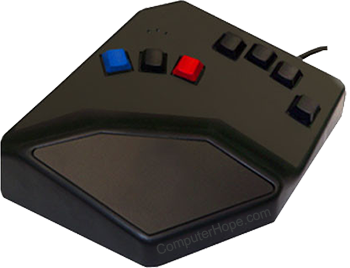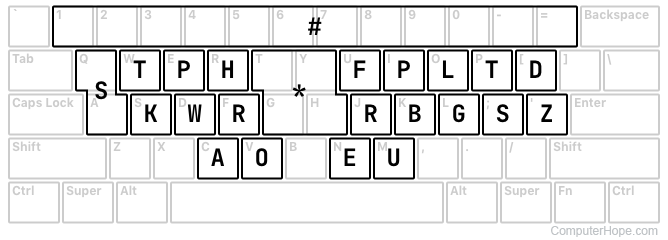Chorded keyboard

A chorded keyboard uses a small number of keys to input letters, words, or phrases by pressing multiple keys simultaneously. Unlike traditional keyboards it relies on "chords" (combinations of key presses) to generate output, much like playing chords on a piano. A chorded keyboard may only have six keys, but pressing two or more keys can create a four-letter word. The picture shows an early example of a chorded keyboard (the BAT keyboard from Infogrip). To type "hi" with the BAT keyboard with the left-hand fingers on the four keys, press the ring and middle finger for "h" and index finger for "i." Other letters require different combinations that may also press one of the three colored buttons with the thumb. Each combination of key presses generate a specific letter or symbol.
A chorded keyboard may also be called a chording keyboard, chord keyboard, or a chorded keyset.
A "chord keyboard" or "chorded keyboard" should not be confused with a "cord keyboard" or "corded keyboard," a keyboard with a cord (cable).
The first popular use of chorded keyboards was the stenotype machines used in the 1800s. The stenotype machine was invented in 1868 as a way for someone to record the dialogue in a courtroom. Later, innovators like Douglas Engelbart also experimented with chorded keyboards for the left hand while moving the mouse with the right and demonstrated it in The Mother of All Demos.
Today, chorded keyboards are still used, including steno machines in courtrooms, braille keyboards, one-handed keyboards, and phone and TV captioning devices.
Chorded keyboard vs. traditional keyboard
The following table gives a comparison between a chorded keyboard and a traditional keyboard used with a computer.
| Feature | Chorded keyboard | Traditional keyboard |
|---|---|---|
| Key count | Between 6 and 12 keys | Typically 104 keys |
| Typing method | Press multiple keys simultaneously | Each key creates a character |
| Learning curve | Requires a lot of memorization and often training | Can be used with little or no training |
| Speed | Faster with practice can achieve speeds of around 200 WPM (Words Per Minute). | Limited to how familiar the user is with the keyboard but most can achieve speeds of 60 to 120 WPM. |
What is Plover?
Plover is a free, open source stenography engine that translates the strokes you press on your steno machine or standard keyboard into entire words. Below is an example of how keys are mapped using this software on a QWERTY keyboard.

Accessibility, Braille reader, Keyboard, Keyboard terms, One-handed keyboard, Telegraph
